As an HR leader, how do you know which data points to prioritize?
Answer: You shouldn’t be prioritizing any particular data point. When you’re trying to make a change based on numbers, you want to act on trends instead.
A trend is the direction in which something’s moving. A data point is just a number fixed in time with no context.
What does this look like in practice for a people and culture leader?
Let’s say you have an excerpt from your latest employee engagement survey that says 85% of employees are satisfied with their employee benefits package.
On the face of it, this sounds like a good thing. 85% is a pretty high number, after all. But this is only a data point.
It doesn’t tell you how many employees were satisfied with their employee benefits package the year before.
If you find out that the year before 88% of employees were satisfied with their package, and the year before that 95% were satisfied with their package, now you’ve got a different story.
Suddenly, that 85% satisfaction rate isn’t so impressive, because you’re trending downwards. Your satisfaction scores are dipping.
On the flip side, a company with a 65% employee engagement score in year 3, a 60% engagement score in year 2, and a 55% engagement score in year 1 has some pretty exciting information on their hands.
They’re trending upwards.
Whatever changes they’ve been making are working and they can continue doing what they’re doing.
Trends are helpful for organizations, especially people and culture teams. They help your organization know what’s working and what needs improvement.
Trends are for meaningful change.
Data points are for vanity PR exercises.
As a people and culture leader, understanding your trends in important areas is a powerful capability to have in your toolbox.
Not only does trend information make you a more effective people and culture leader, it also allows you to back up your proposed initiatives with proof and gain a seat at the table.
You can arrive with the numbers to make your case – or prove your success – in the same way your colleagues in sales and finance can.
So how do you collect this data as a people and culture function?
By using pulse surveys.
What are pulse surveys?
Pulse surveys are short questionnaires distributed on a frequent basis.
Since pulse surveys are great at tracking trends, it’s useful to distribute the same questionnaire throughout the year, so you can measure employees’ responses to the same questions.
Annual employee engagement surveys are usually only a reflection of how employees are feeling at the end of the year.
The results may be overly positive or overly negative due to recency bias.
Annual employee surveys also have some key limitations.
For one, they’re quite long which can cause survey fatigue.
Making the survey mandatory isn’t always a solution to this problem. Your employee may just want to get the whole thing over with and wind up satisficing.
Satisficing is when respondents put minimal effort into their survey responses. Examples of satisficing are:
- Picking the first response in a list of options because it’s “close enough” rather than reading the entire list of responses
- Selecting “don’t know” instead of providing an opinion
- Randomly choosing responses so you can speed through the survey
Another way employees get through survey fatigue is by straightlining. Straightlining refers to providing the same response (e.g. “Neutral”, “Strongly Agree”) for every survey question.
There’s another common problem when it comes to designing employee surveys: the questions companies choose.
Sometimes, annual surveys are a combination of random questions that have very little bearing on employee satisfaction.
One data point about how much employees enjoyed the holiday party is not especially meaningful or helpful.
Trend data about how employees feel about your organization's ongoing engagement efforts is.
While annual surveys give you a snapshot of a moment in time, pulse surveys help you understand patterns and trends over the entire year. They can help you understand your workforce, prioritize your people and culture projects, and track the success of your initiatives.
If you’re unsure how to get started, here are 19 questions to ask in your pulse surveys.
Here are 19 questions to ask in your pulse surveys:
Survey questions about employees’ personal experiences
- I would recommend our organization as a great place to work
- I feel a sense of belonging at this organization
- I am excited about our organization's future
- Our organization has a great culture
- Overall, I am satisfied with how decisions are made at this organization
- I have confidence in the leadership team
- Our organization does a good job of communicating with employees
- I enjoy the colleagues I work with
- I would recommend my direct manager to others
- My direct manager provides me with feedback that helps me improve my performance
- I feel satisfied with the recognition or praise I receive for my work
- I feel empowered to make decisions regarding my work
- I know what I should be focusing on right now
- I have good career opportunities at this organization
- I have good opportunities to learn and grow at this organization
- The work that I do at this organization is meaningful to me
- My role is an excellent fit with my strengths
- I have the resources I need to do my job well
- I am able to successfully balance my work and personal life
Pulse survey questions
I would recommend our organization as a great place to work.
Dissatisfied employees pose both turnover risk, performance risk, and reputational risk.
In 2021, nearly half of employees in Canada say that they’re seriously considering leaving their roles due to job dissatisfaction.
That dissatisfaction stems from a lack of connection to their colleagues, increased workloads, and minimal support from their superiors.
Turnover represents a huge cost for employers, especially when replacing in-demand candidates in specialized roles. It’s worth keeping the employees you’ve already got, as happy as possible.
Employee dissatisfaction is also a performance risk. Dissatisfied employees do not use high discretionary effort (aka go beyond the minimum requirement) when doing their jobs.
High discretionary effort is essential in order to compete. In today’s knowledge economy, it’s difficult to assess when employees aren’t using their full brain power, problem solving skills, and creative potential. They’re more likely to invest if they care.
If they don’t care, a company with more engaged employees will solve customer problems faster, develop new and innovative products and services, and work more collaboratively with their colleagues. Companies lose an estimated $450 to $500 billion per year because of dissatisfied and disengaged employees.
Finally, dissatisfied employees also pose reputational risk. Dissatisfied companies are less likely to recommend the company to others in their network and they’re more likely to share bad reviews (either in person or online) about their company.
An estimated 1 in 3 people have turned down a job offer because of bad reviews online. Developing and protecting your employer brand is important if you want to attract the best talent and access your best workers’ professional networks for referrals.
I feel a sense of belonging at this organization.
Humans are built for connection, and this characteristic doesn’t disappear when they go to work. Even when stifled, the need for belonging rears its head and sees if any can be found at work.
When employees don’t feel a sense of belonging, they’re less likely to fully engage with their work and go beyond the bare minimum to help meet business goals.
40% of employees say they don’t feel a sense of inclusion at work. While it’s tempting to dismiss “belonging” as something irrelevant to work, creating this kind of culture can have a meaningful impact on a company’s bottom line.
A sense of belonging at work can lead to a 56% increase in job performance, a 50% reduction in turnover risk, and a 75% drop in the number of sick days.
Workplaces can create a sense of belonging by:
- having a zero tolerance policy towards microaggressions and inappropriate remarks
- addressing instances of discrimination head on and with a clear and transparent policy
- encouraging managers to have more one-to-one meetings with their team members
- using pulse surveys to keep tabs on how included employees feel and identify the causes of exclusion
I am excited about our organization's future.
Millennials have developed a reputation for being job hoppers – 6 in 10 millennials say they’re open to new job opportunities – but this may not be entirely fair.
Within every generation, people job hop early in their career to find the perfect fit.
One of the ways they determine this is by assessing a specific company’s future. Employees are asking themselves questions like:
- Is this company staying on top of trends, or are they sticking to old ways of doing things that will make them irrelevant and uncompetitive over the long run?
- Are there opportunities for advancement in this company, or are the interesting projects relegated to a certain group of people?
- Does this company’s management operate ethically and transparently? Is this a brand I want to associate myself with?
- Is there a positive company culture here, or will it be difficult for me to be happy within this organization over the long run?
If the answers to these questions are negative, then you probably don’t have employees who are excited about your organization’s future.
You want employees who see themselves with your organization long term, otherwise, they won’t give their jobs their full effort.
Our organization has a great culture.
A company’s values, the predominant attitudes, and the behaviours that get rewarded make up its company culture.
A company’s culture can either motivate its people or chip away at its morale.
A poor company culture can cause reduced employee engagement which often leads to lower performance and higher employee turnover.
Chances are high that your people and culture team routinely works on ways to improve the company culture.
This could be through training for your managers, support groups and networks for your employees, professional development opportunities, and more. With so many initiatives on the go, it can be difficult to determine what’s working and what isn’t.
By asking your employees to agree or disagree with the statement, “Our organization has a great culture” every month or every quarter, you can get a greater sense of how your employees feel about your company’s culture over the entire year, not just at the end of it.
In addition, you can get a better sense of which initiatives and which changes have the most positive impact and reallocate your HR team’s time and resources accordingly.
Overall, I am satisfied with how decisions are made at this organization.
Flat or horizontal organizational structures are considered more useful for innovative organizations.
Collaboration, decision-making, and innovation are easier when people can work across teams and are not constrained by a hierarchical organization and the “positional authority” that comes with it.
Today’s leaders often want the benefits of a flat organization (e.g. shared accountability, self-sufficiency, resourcefulness) while retaining the power of a hierarchical organization (e.g. authority).
This often results in a situation where employees don’t get the benefits of a hierarchical organization (e.g. I do my job that’s been clearly outlined and I can stick around so long as I don’t rock the boat) but they get all of the costs (e.g. I’m expected to figure things out, take on countless responsibilities on my own in a role that isn’t clearly defined, but I don’t get a say in meaningful decision making processes).
If you’re trying to encourage innovation and collaboration, it’s important to understand whether your employees are satisfied with how decisions are made within your organization.
Do they feel like they have a say? Do they feel like important decisions that impact their work happen without their consultation? Your pulse survey can help you find out.
I have confidence in the leadership team.
Teams have to be flexible and adaptable.
Sometimes, changes in the market or crises require employees to step outside of their comfort zone or put in a little more effort than usual.
Doing this requires trust in the leadership team’s ability to navigate a company through this time.
If your employees don’t have confidence in you, they’re less likely to stick by you.
The last thing you want is employees jumping ship when things get rough.
But if you’ve been unreliable, uncommunicative, disrespectful, or unsupportive during regular times – or during previous crises – they’re less likely to hunker down and have faith.
Even something that could be advantageous in the long-term, but uncomfortable in the short-term – like a merger – can turn into a mass turnover event if employees don’t believe their leadership team is looking out for them.
If your pulse survey results show that your employees have minimal confidence in the leadership team, you can fix this, but it won’t be fixed with one initiative or one statement.
Instead, you’ll need to demonstrate through consistent employee recognition, internal communications, and consultations that you’re actively changing. Use your pulse surveys to gauge whether these changes are having an impact.
Our organization does a good job of communicating with employees.
Meaningful and consistent internal communications have a positive impact on employee engagement and this in turn has an impact on your retention.
So it’s worth asking employees how happy they are with internal communications. Internal communications can benefit your company by:
- limiting the amount of stress, worry, and gossip related to big changes like a well-liked and longtime leader leaving or a rumoured merger
- building confidence in the leadership team and their level of transparency with employees
- getting people on board with a major change in direction for the company
- creating a sense of inclusivity and belonging among employees
- clearly articulating the company’s business goals and values
- highlighting and recognizing employees who’ve demonstrated a commitment to the company’s values through their actions
If you receive low scores on this question, you can take the following steps to improve your internal communications:
- adding internal communications to a specific individual’s job responsibilities (e.g. someone in either marketing or HR)
- developing an overall internal communications strategy so that your organization’s internal communications are not just a mix of random emails and blog articles from different leaders
- gathering feedback from employees on what they’d like to know more about and through which channels (e.g. email, intranet, social media)
I enjoy the colleagues I work with.
Research shows that employees who have a work best friend put in much more effort.
This is partly because people now expect their jobs to provide more than just a paycheque. They expect their jobs to be meaningful, aligned with their values, and an enjoyable place to work most of the time.
Plus, the dividing line between our work lives and personal lives has become fuzzier with many people spending more time with their colleagues than they do with friends and family.
With work taking up a significant chunk of people’s lives and self-worth, it’s only natural that they’ll expect to feel a greater sense of connection with the people they work with.
Of course, many leaders may say it’s not their job to facilitate friendships and connections in the workplace, and that’s a fair point of view.
But given the impact of having a “work best friend” or at least some “work friends” on an employee’s productivity and engagement, it’s worth tracking how much your employees enjoy the people they work with.
This doesn’t have to be a frivolous question. Your employees may report that they don’t enjoy working with their colleagues because there’s poor collaboration, not enough communication, or outright toxic behaviour.
I would recommend my direct manager to others.
This question can help you identify whether your managers need more training or if there are a handful of managers causing a higher proportion of your organization’s turnover than others.
Keep in mind that not all bad managers are malicious or toxic. They just may not have the skills to empower your team, mobilize them effectively, give them the right direction, or eliminate obstacles.
Nevertheless, a well-intentioned but incompetent manager can lead to attrition just as much as an awful manager can, so keep an eye out for this issue before it impacts your employee turnover rates.
My direct manager provides me with feedback that helps me improve my performance.
Do your employees receive feedback from their managers? Is this feedback delivered regularly? Does it have substance?
Use your employee pulse surveys as a way to find out. Regular feedback gives employees an opportunity to improve, but managers don’t always prioritize regular touchpoints.
This is where a pulse survey offers double the value. What gets measured, gets managed. If managers know that their team members will be regularly asked about whether they receive enough feedback, they’ll be more likely to make time for it
I feel satisfied with the recognition or praise I receive for my work.
Your best employees go above and beyond their job description. They solve problems, get creative, and build the internal relationships needed to collaborate and communicate with their colleagues.
Hanging onto these superstar employees is a high priority, but it’s also easy for companies to take them for granted.
Your top performers may notice that they’re doing double the work for the same amount of pay as their coworkers. Or they may notice that they’re picking up the slack of a co-worker. Since it’s not in a top performer’s nature to do less, they’ll likely look for opportunities elsewhere.
If you rank poorly on this question you can introduce a formal recognition program or evaluate how often you are promoting employees.
I feel empowered to make decisions regarding my work.
Employee autonomy plays an important role in employee engagement.
Employee autonomy is an employee’s ability to do their work how, when, and where they do it best.
This is especially true for knowledge workers whose value or output isn’t tied to how long they’re in the office or when they’re in front of their computer.
High performing employees who don’t have autonomy either go to companies who give them freedom or strike out and start their own ventures.
I know what I should be focusing on right now.
Do your employees have a clear understanding of what their tasks are? Uncertainty about expectations can lead to:
- avoidable errors
- frustration and eventual apathy
- Disengagement and turnover
If you’re receiving low scores on these questions, this is an opportunity to encourage your managers to conduct one-on-one check-ins and set clear goals and objectives with their team members.
I have good career opportunities at this organization.
Do your employees feel like they have an opportunity to advance? Your high performers will have their eye on moving upwards. As a people and culture leader, you want that upward trajectory to happen with your organization. Otherwise, other companies — including your competitors — will benefit from all the time you spent developing these superstars.
I have good opportunities to learn and grow at this organization.
Professional development is key to keeping employees engaged. Your best employees will want opportunities to learn and grow. Making these opportunities available internally are what keeps these employees with you over the long term.
This question is also useful for identifying inclusion issues. In some organizations, high-profile projects and opportunities are made available through mentorship networks. If these mentorship opportunities come up informally (e.g. personal relationships, affinity bias) some of your top employees may be missing out on growth and development opportunities.
The work that I do at this organization is meaningful to me.
Look for opportunities to connect your employees’ work back to the company’s business goals or larger business values. How is what your employees are doing impacting people’s lives or their communities in a positive way? Once you’ve identified this, use your internal communications strategy to share these stories with your organization.
My role is an excellent fit with my strengths.
Sometimes, an employee isn’t performing well because they’re in the wrong role. Your employee satisfaction survey can help you identify misalignments and create programs for employees to transfer internally. This can be done by actively promoting roles internally to “candidates” who already know the company well.
I have the resources I need to do my job well.
Do your employees have the technology and tools they need to do their work well? Given the massive shift to hybrid and remote working models, ensuring employees have access to the right tools is critical to creating an effective work environment.
I am able to successfully balance my work and personal life.
Work/life balance is more important than ever. In a post-pandemic working world, employees are re-thinking the types of jobs they want and willing to leave their current roles in search of greater work/life balance.
The benefits of a robust pulse survey platform
A robust employee pulse survey platform such as Sparkbay can help leaders understand obstacles and opportunities and focus their efforts where it matters. It can also track engagement and satisfaction over time to identify which actions are working and which aren't.
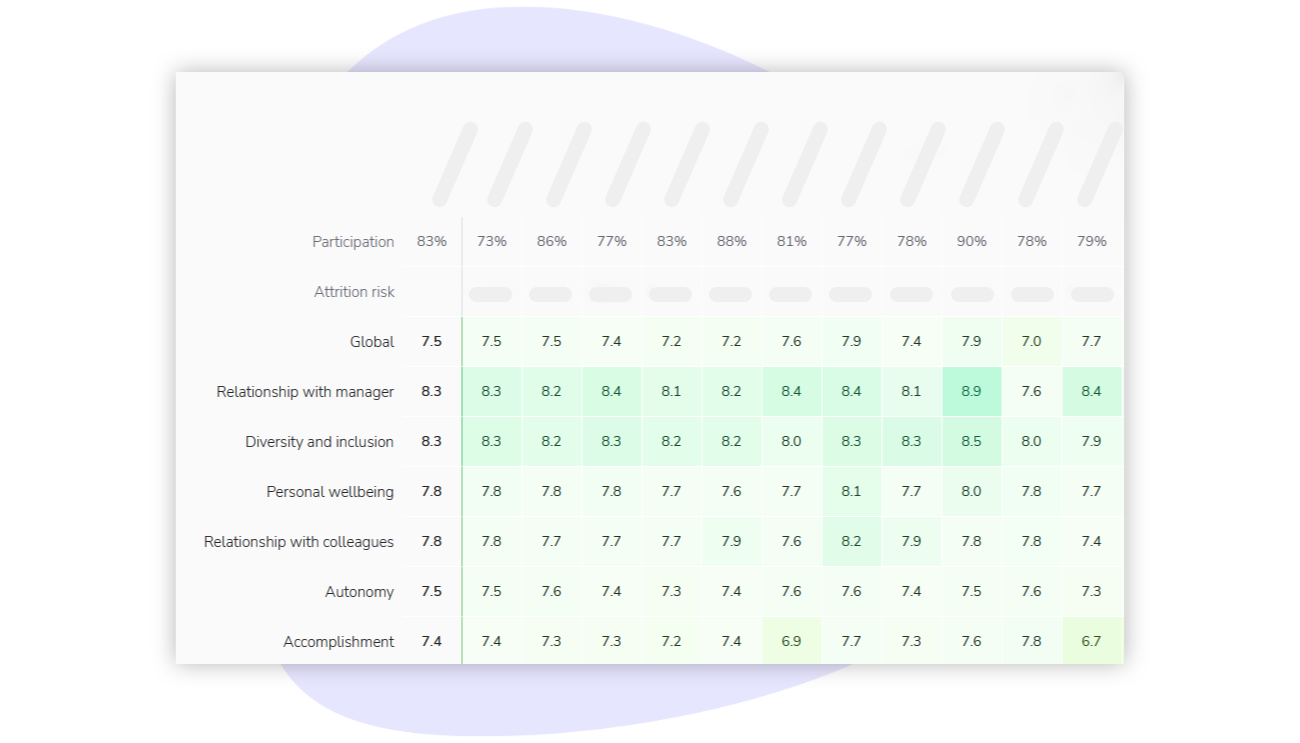
Explore employee data any way you want
It is important to be able to segment data based on demographics such as tenure and role. Sparkbay allows leaders to interrogate their data in any way they want to uncover deeper insights about their people.
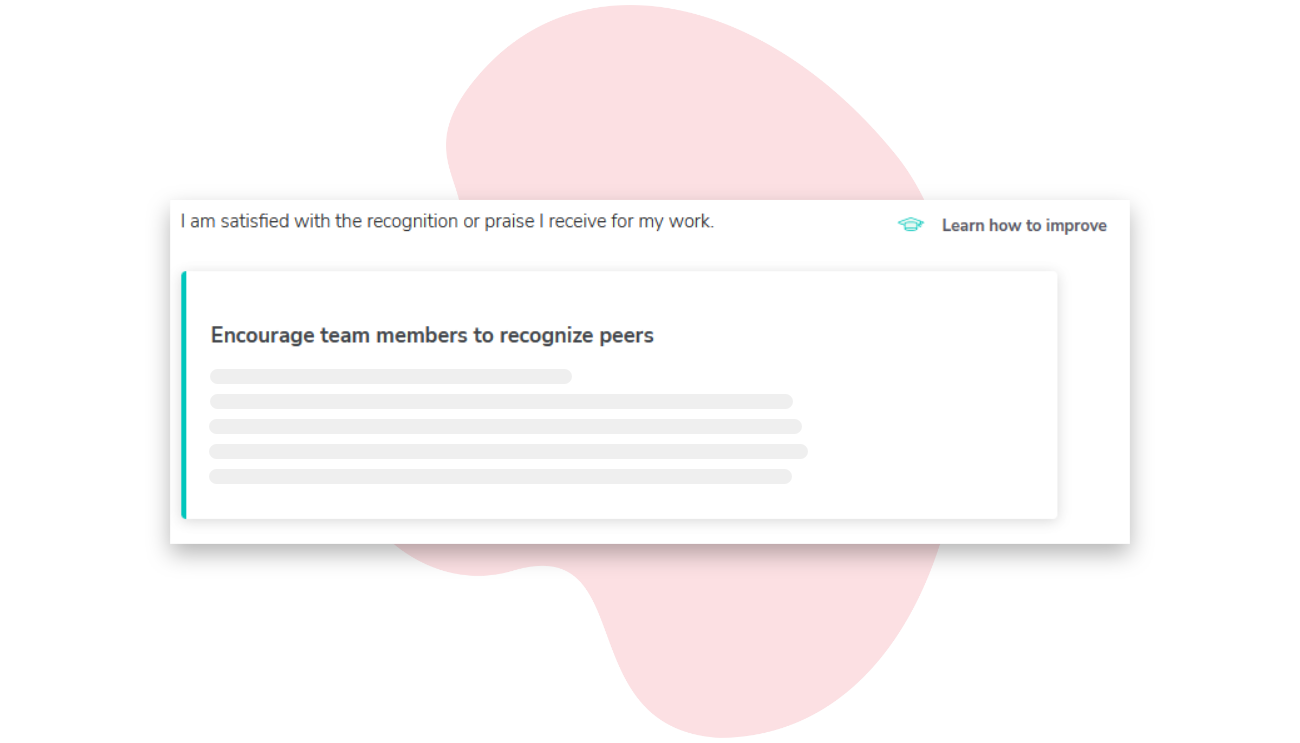
Empowers action
Surveying employees serves no purpose if leaders do not take advantage of the opportunities they discover. With Sparkbay's automated coaching, managers can act on easy-to-implement strategies. These tools drive action to ensure you meet your employee-centric objectives.
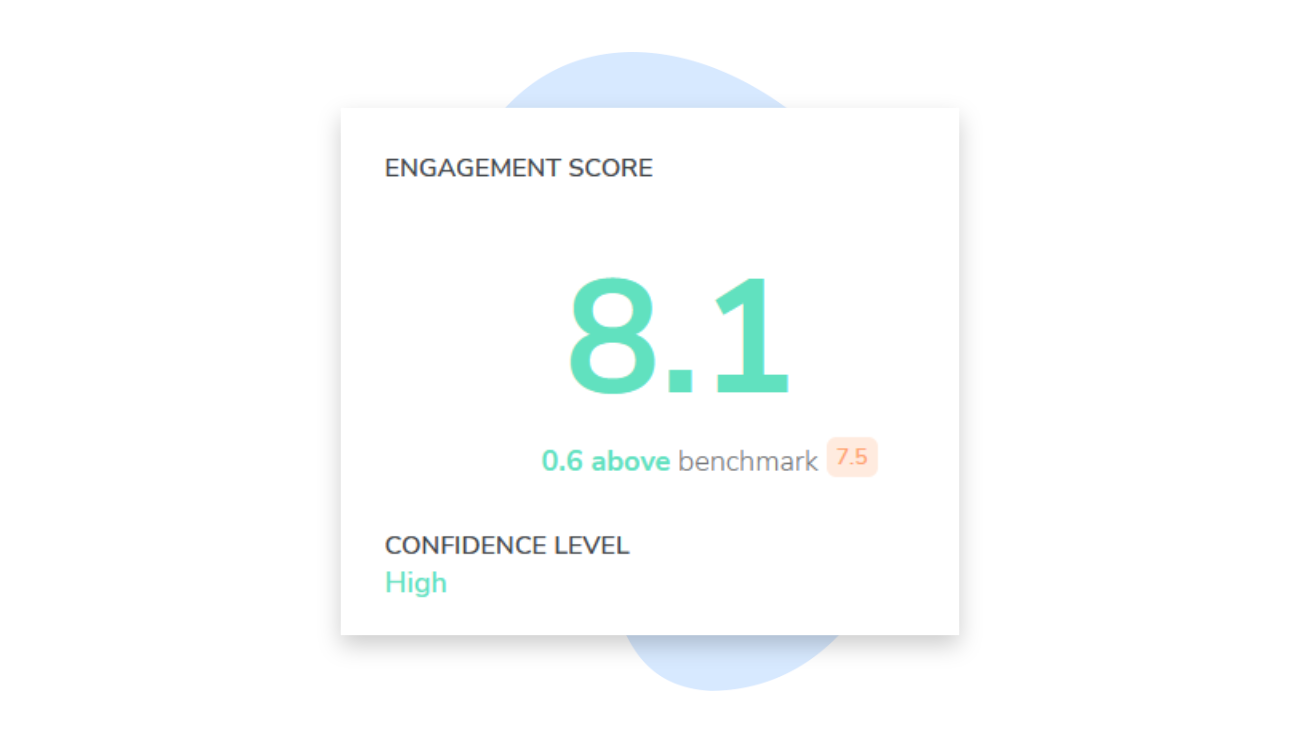
Provides robust benchmarks
Leaders need to compare their survey results with industry benchmarks to understand how they are doing. Using the right survey platform, you can compare your survey data with others in your industry, similar-sized companies, and top employers.
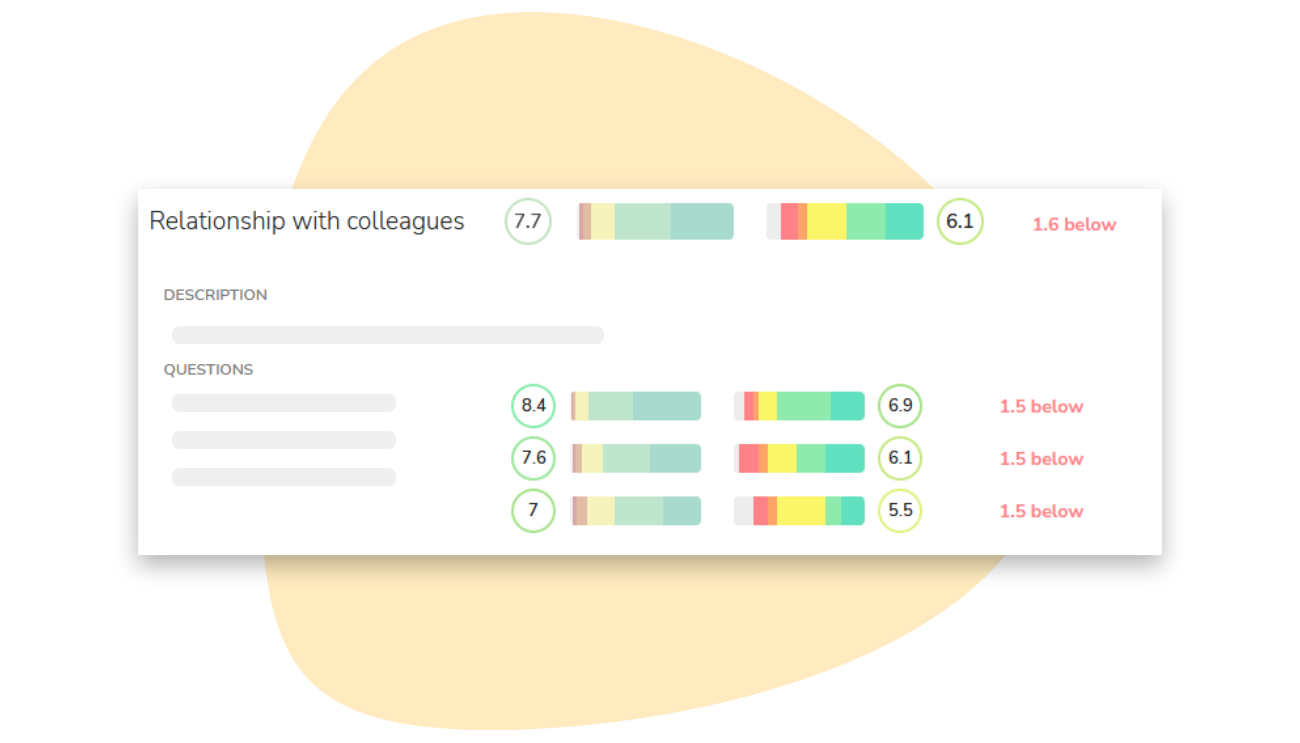
Equips managers with dashboards to visualize their results
Manager dashboards help managers visualize their survey results all in one place. With these dashboards, managers can easily track employee experience trends, and identify strengths and opportunities.
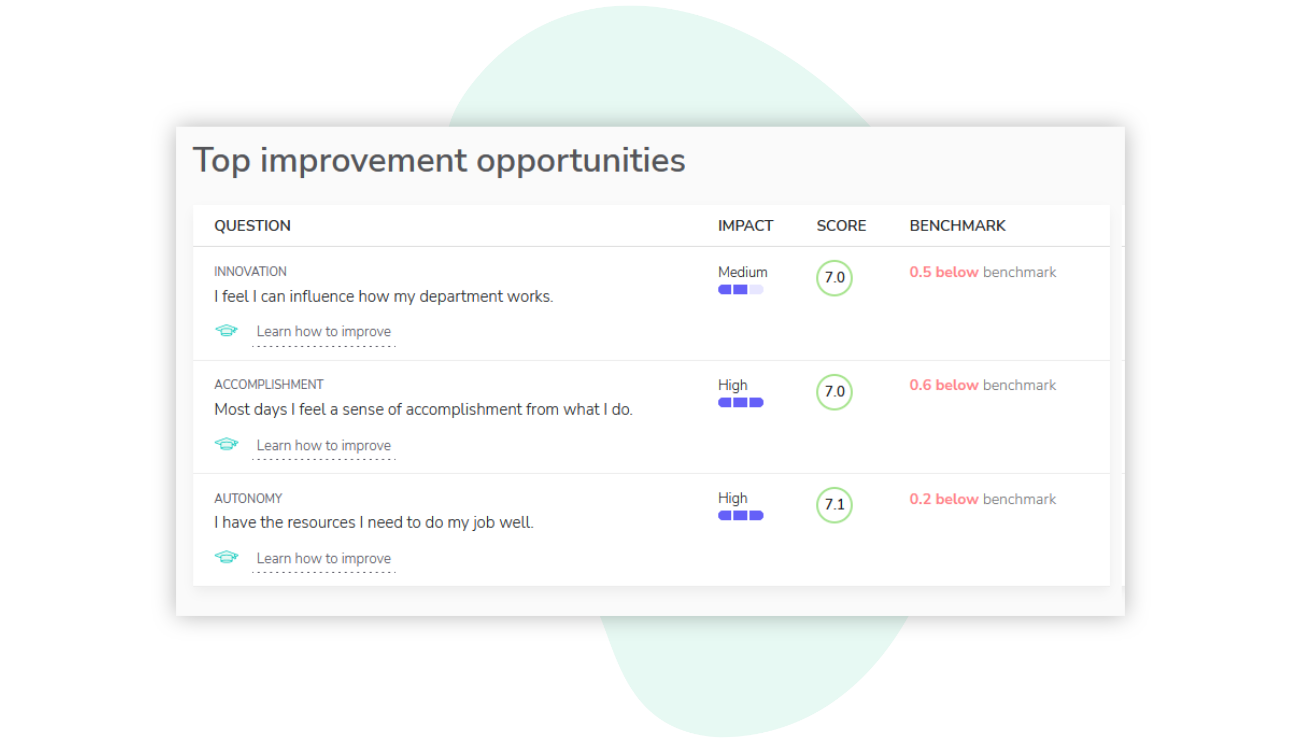
Provides a seamless user experience
You don't want your managers to waste valuable time on a clunky, hard-to-use platform. We designed Sparkbay with simplicity in mind. Your managers will master our intuitive dashboards in no time.

Gain access to real-time results
Taking action is the most significant part of your survey strategy. That’s why Sparkbay's real-time results let you expedite your process and propel insights into action.
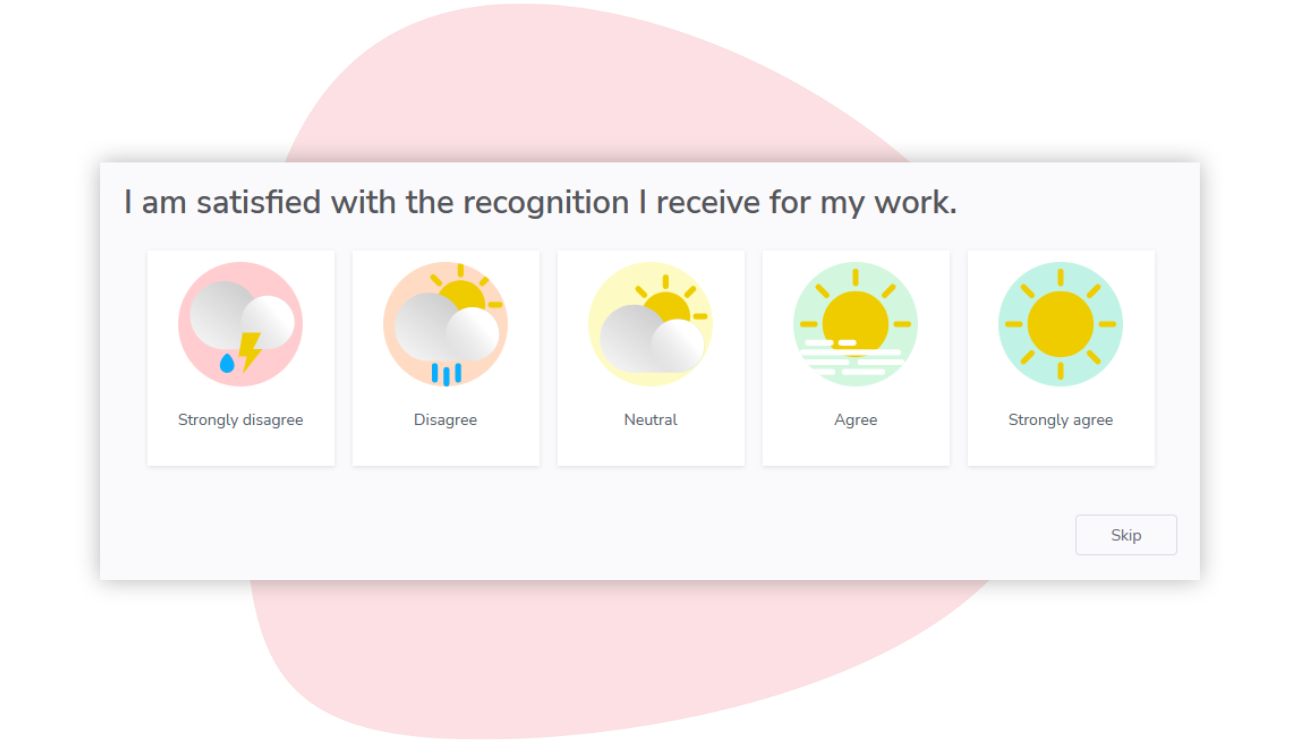
Offers science-backed questions on key workplace topics
To get the insights you need, you have to ask questions that resonate. Sparkbay offers science-backed questions on key workplace topics such as diversity and inclusion, change management, employee benefits, and more.
Measuring and improving employee satisfaction through employee pulse surveys is straightforward and effective when you adopt an approach that works.
By using a robust pulse survey platform to administer the right survey questions, you can easily collect employees’ feelings and sentiments to put these insights into context.
Sparkbay’s employee engagement software simplifies the process of distributing pulse surveys. You can automate who receives specific pulse surveys and schedule their distribution at frequent intervals to collect the right data, document trends, and generate the valuable employee insights that will help you engage your employees and improve your workplace culture.
If you're interested in learning how Sparkbay can help you survey your employees, you can click here for a demo.

